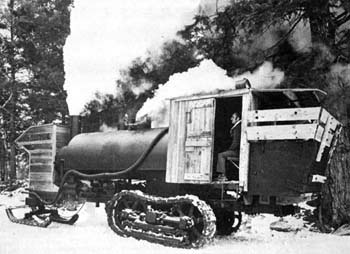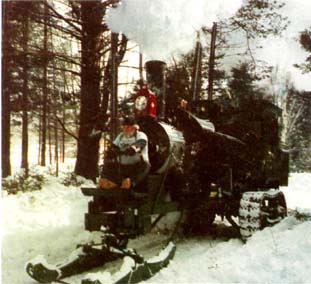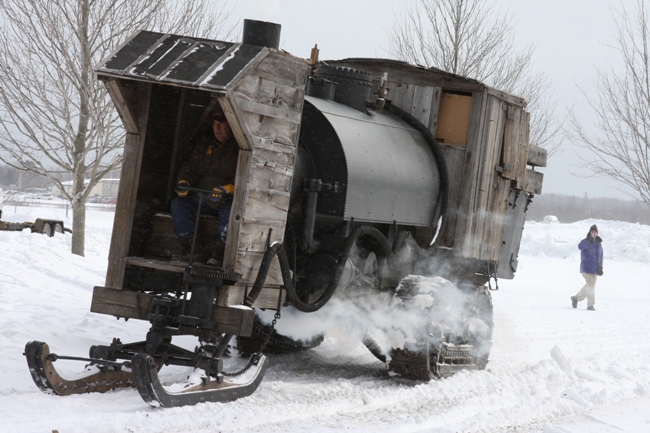The Lombard Steam Log Hauler was an invention that came from the mind of a talented Maine mechanic named Alvin Lombard.
 Logging was and is extremely tough and dangerous work. Even after all the technical developments of the last 100-plus years it still claims the lives of men at a frightening clip. One can only imagine the danger back at the turn of the last century.
Logging was and is extremely tough and dangerous work. Even after all the technical developments of the last 100-plus years it still claims the lives of men at a frightening clip. One can only imagine the danger back at the turn of the last century.
Of all the jobs, pulling the felled trees from the woods to staging areas where they could be transported to the sawmills was the most horrific. The logs were dragged out if the forest by teams of oxen or horses. The secret behind the success and danger in this job was the downward grade of the road. The horses and oxen could not drag the logs uphill, so every logging road started high and ended low. Runaway logs, logs that rolled off the road, and others that slipped from their harnesses, killed horses and oxen with regularity. The also maimed and killed the men driving the teams of animals.
There had to be a better way. Legend has it that Lombard picked up on the ideas of another budding inventor named Johnson Woodbury who had big plans, but no means to follow through. He relayed his ideas to Lombard who at the time had already come up with some commercially viable inventions and had the horsepower to build this machine, assuming there was a demand. In a perfect meeting of fate, Lombard happened to find himself sitting on a train next to a logging company executive who told him that his company would be first in line to buy a machine, provided that it worked.
He set to work immediately drawing up plans and approached the Waterville Iron Works to actually construct the behemoth, and filed for the patent on the machine. The date was November 9, 1900, and the construction of the prototype was well underway.
Work was completed just a couple weeks later on Thanksgiving and it was on that day that the machine made its first public appearance. It was not all that impressive as the machine started shattering its tracks as soon as it transitioned from snow to hard ground.
The problem was in the grade of steel used. After monkeying around with the recipe they came up with a very durable steel that suited the job to a T.
The first machine must have scared the crap out of the local Mainers. It had an upright boiler and an independent steam engine for each set of tracks. Turns were made by varying the speed of the engines, and with a team of horses hooked to the front of the beast to guide the front end around.
This was quickly ditched for a set of front runners that were steered with a massive wheel. We have no clue what the ratio was, but we’ll suffice to say it was slower than an ocean liner.
The upright boiler and multi engines were tossed in favor of a normal, locomotive-style lay-down boiler and single engine that used a differential to help vary the speed of the tracks. That power plant came from a railroad yard engine and was the de facto engine used to power the majority of the machines that were produced. The lay-down “saddleback” style boiler also placed more weight to the rear of the machine and increased its traction and hauling ability due to the fact that the water tanks were slung over the side of the main boiler body.
It was 1903 when the first machine was sold to a logging company in Maine, and soon the orders began rolling in. The machines were shipped all over the country, and Lombard even licensed a company in Wisconsin to build the machines under his name. In total 83 of the slow moving tugs would be built, most powered by steam, but a few later ones were powered by gasoline and one was built with a diesel.
Watch a Lombard chuff by! This video was taken days ago –
Because of the fact these were used in logging, many operators used wood to fire the boilers, and they used LOTS. Those of you warm weather dwellers may not be able to visualize 350 cords of wood, but that’s about the amount they would burn in order to pull 3 million board feet of wood, which sounds like a lot, but in comparison to the amount of fuel used, it ain’t. In fact, some of the companies had full teams of employees whose entire job was to supply the crawlers! Back when labor was cheap. Coal power was far easier to manage and was the main source of fuel used except during some periods during WWI when coal was a scarce commodity.
As a quick side note the one and only diesel machine produced was built in 1934 at the tail end of the company’s run, literally. Trucks had become the normal mode of transport as they were faster and more maneuverable. The first diesel was the last Lombard.
On to the good stuff. How did these things operate? A crew of three men, the first called a steersman who sat at the front of the machine and was tasked with keeping the hauler  between the ditches. He sat in a small enclosure that was open to the elements, but at least he had a roof. Because the machine had no brakes and the only way to slow it was to reverse the engines, hills must have been scary as hell. He must have been working his wheel like a mad man.
between the ditches. He sat in a small enclosure that was open to the elements, but at least he had a roof. Because the machine had no brakes and the only way to slow it was to reverse the engines, hills must have been scary as hell. He must have been working his wheel like a mad man.
At the back of the hauler were the engineer and conductor. The engineer shoveled coal, and monitored the health of the engine while the conductor was in charge of the while train of logs. He would have been known as a brakeman on a normal train.
The train could consist of up to 12 cars full of logs if conditions warranted it. Each car could hold up to 6,000 board feet of logs. Trips ranged anywhere from 3-5 miles if the logs were going from the forest to the river and up to 20 miles if they were going all the way to the mill. We’re not sure of the speeds the machine traveled at, but if it was any more than 5 miles per hour we’d be shocked.
Ironically it would be another tracked vehicle, the bulldozer, that would bring to an end the usefulness of the Lombard hauler. Because a dozer could create a passable road into the forest, it allowed the new generation of trucks to start pulling loads out of the previously inaccessible forest. They were faster, more maneuverable, and overall far more efficient than the coal hungry haulers. The end was neigh.
In 1934 the company finally folded after producing 83 working machines. They had been primarily used in New England, but like we said before, a few headed out west, and three went to Russia. Only a handful survived to today as the majority were abandoned in the woods or cut up for scrap once they were retired. If you’re ever interested in seeing one in person head to Patten, Maine, and the Maine Lumberman’s museum as they have a fully restored model.
We’d love to drive one!


















